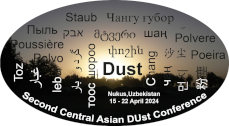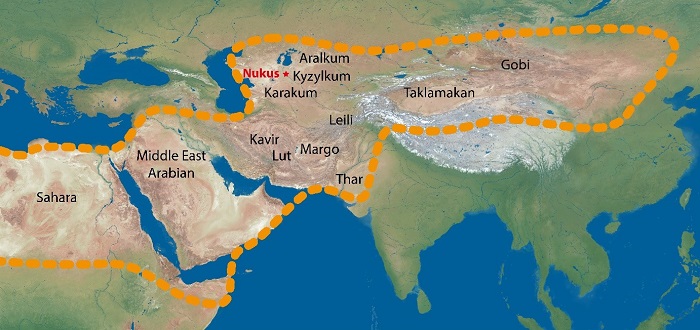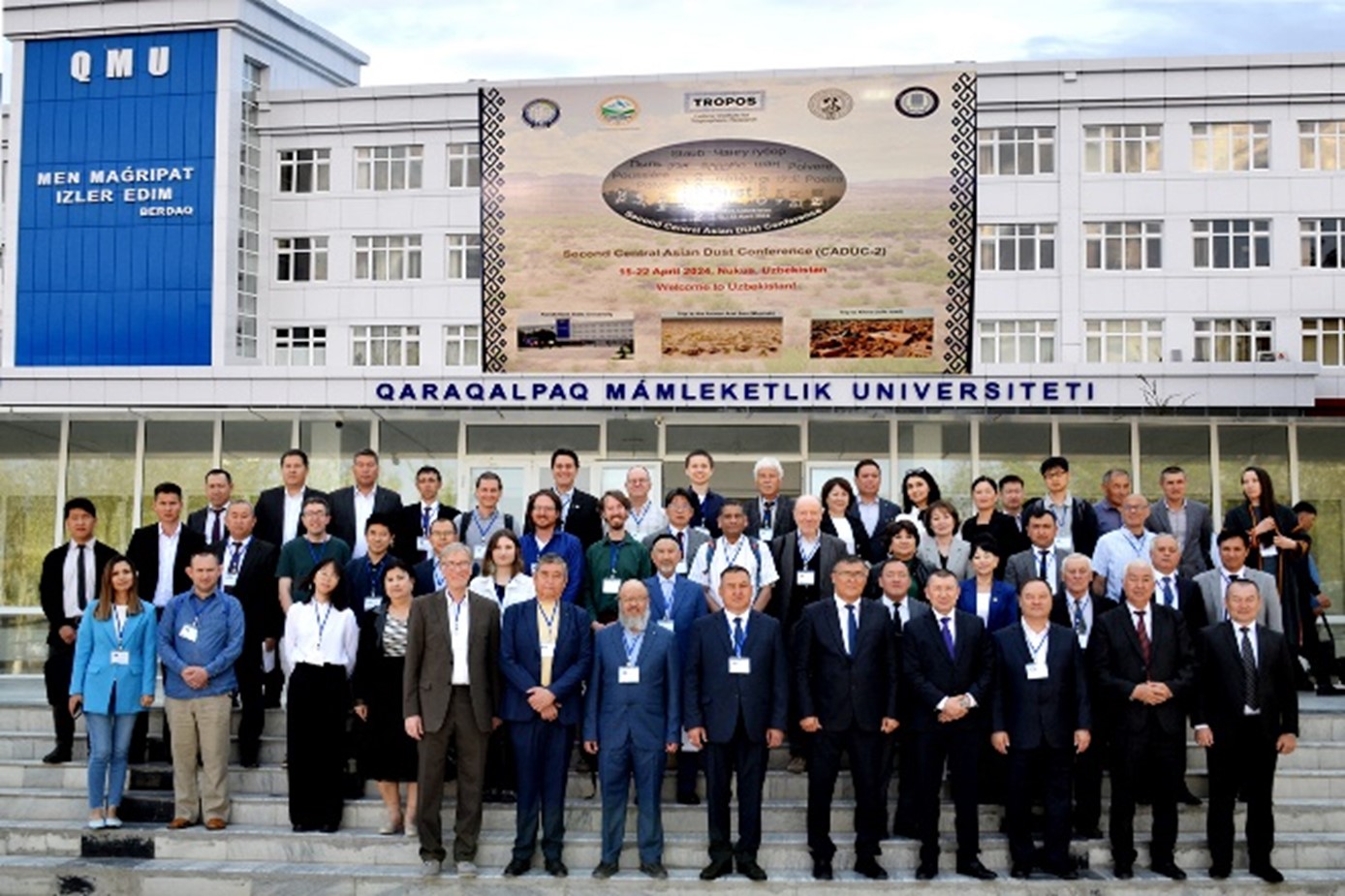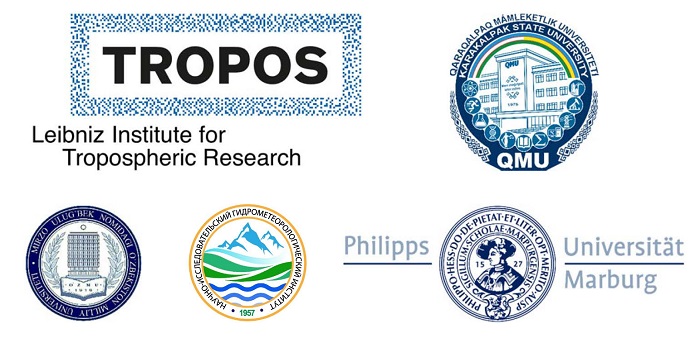CADUC 2024

Second Central Asian DUst Conference (CADUC-2)
15-22 April 2024, Nukus, Uzbekistan


Preface
The Second Central Asian DUst Conference (CADUC-2) gained more insight into the different aspects of Asian dust and dust in other regions of the world. Special focus was put on the Aral Sea respectively the Aralkum as an increasing dust source in Central Asia. The conference brought together scientists in Central Asia. Worldwide, the conference created a better presence of the issue of Asian dust in Central Asia. The conference contributed to the cooperation of different countries regarding the Asian dust. Last but not least the conference supported capacity building, especially in contributing to the education of young scientists regarding the Asian dust in Central Asia.
Sessions
- Atmospheric dust at source regions
- Dust properties at transport
- Atmospheric dust at sink regions
- Aral Sea region as dust source and dust sink
- Impacts of atmospheric dust
- Dust early warning systems
- Success stories in controlling sand and dust storm (SDS) hotspots
Policy recommendations
- Central Asia is particularly vulnerable to dust storms. There is a critical gap in understanding and mitigating the impacts of dust storms in the region. Until now, there is no WMO regional Sand and Dust Storm Warning Advisory and Assessment System (SDS-WAS) center for Central Asia. The WMO regional centers in Barcelona, Beijing and Jeddah only partly cover Central Asian dust emissions. A new regional dust forecast center for the region would be highly desirable.
- Reinforcing science cooperation between countries because dust is an international problem (transboundary, regional, continental, intercontinental). Especially, it is recommended to strengthen cooperation between research institutes and WMO regional centers specialized in sand and dust storms (SDS).
- In the Aral Sea region, first of all, practical field studies should be carried out to assess the environmental impact of dust, salt, and sand emissions from the dry bottom of the Aral Sea. In particular, it is necessary to study the movement of dust, salt, and sand in this region and beyond. Investigations should address the natural geoecological processes in the region, the phenomenon of desertification, the spread of soil, vegetation, salt and sand, as well as climate impacts in regions far away from the Aralkum.
- Since satellite monitoring and retrievals are limited throughout the year in Central Asia or more specifically in the Aralkum region, it is highly encouraged to enhance the ground-based monitoring capabilities, e.g., from a sun photometer or even a vertical profiling instrument (lidar). Ideally the measured data should be made public via some of the already established platforms (e.g., AERONET).
- Adequate remote-sensing monitoring systems should be installed. These should include a multi-method approach: ground-based observations, satellites and models. New reanalysis products are essential for the region of Central Asia. In order to correctly assess the impact of dust from Central Asia on air quality in downwind areas, it is necessary to monitor where and what type of aerosols (e.g., mineral dust, urban pollution, wildfire smoke) are being transported. This is a global effort for which international collaboration is needed.
- There is good progress in the description of seasonal patterns based on satellite observations and modelling, but single events are difficult to recognize in advance (e.g. the event of November 4-14, 2021). It is necessary to develop a dust event warning system for the local population enhanced by ground-based observations.
- Dust storms can substantially reduce the yields of crops, trees, pastures and livestock. Policymakers should take action to mitigate these adverse impacts on agriculture, an important economic sector in the countries of Central Asia. Specific recommendations to reduce the dust emissions and soil loss from agricultural land in dryland areas:
- Agricultural systems should prevent the destruction of dry aggregates during seedbed preparation by considering soil moisture during agricultural practices, such as the timing of sowing, the temporal variations during the day, and the variability in tillage depth.
- Dirt roads and agricultural pathways are serious sources of dust emissions in semi-arid croplands, which can be prevented by the construction and maintenance of paved roads.
- Use the research results to identify key dust-source regions and encourage the national stakeholders to install measures to reduce dust emissions especially in these hot spot regions. An encouraging example is the bilateral cooperation between Kuwait and Iraq in mitigating dust hot spot regions in the Tigris-Euphrates floodplains.
- We recognize that different aerosol components impact health differently. One specific example is aerosol metals because they negatively impact public health. Hence, it is essential to measure their concentrations (along with other constituents by chemical analysis) and to comprehensively characterize aerosol composition as they influence human, plant, and ecological health. Local mitigation strategies on reducing winter emissions from residential heating fuels including coal combustion should be considered to reduce associated health risks.
- A global effort is needed to help dust-affected regions mitigate the losses and damage caused by dust. Initiating this effort should be a central feature of the United Nations Decade on Combating Sand and Dust Storms (2025-2034).
Proceedings editors
Dietrich Althausen
Julian Hofer
Ronny Engelmann
Christian Opp
Scientific Committee
Ina Tegen (Germany)
Bakhriddin Nishonov (Uzbekistan)
Sara Basart (WMO, Swiss, Spain)
Maria Shagedanova (Great Britain)
Ali Al-Dousari (Kuwait)
Jamie Banks (Germany)
Alireza Rashki (Iran)
Asia Khamzina (Korea)
Rashid Kulmatov (Uzbekistan)
Gulomjon Umirzakov (Uzbekistan)
Kerstin Schepanski (Germany)
Sabur F. Abdullaev (Tajikistan)
Kenji Kai (Japan)
Hamid Reza M. Khalesifard (Iran)
Hamidreza Abbasi (Iran)
Zhongwei Huang (China)
Julian Hofer (Germany)
Nobuo Sugimoto (Japan)
Atsushi Shimizu (Japan)
Ali H. Omar (USA)
Guangyao Dai (China)
Dietrich Althausen (Germany)
Christian Opp (Germany)
Rustam N. Eshniyazov (Uzbekistan)
Kristina Toderich (Japan)
Jianping Huang (China)
Nick Middleton (Great Britain)
Buho Hoshino (Japan)
Alima Karlibaevna Berdimuratova (Uzbekistan)
Jilili Abuwaili (China)
Organizers
Karakalpak State University (KSU), Nukus, Uzbekistan
Leibniz Institute for Tropospheric Research (TROPOS), Leipzig, Germany
Hydrometeorology Scientific Research Institute (NIGMI), Tashkent, Uzbekistan
in cooperation with
- Philipps-Universität Marburg, Germany
- National University of Uzbekistan, Tashkent, Uzbekistan

CADUC
Indicates free access to the whole year/issue
TE-RE-RD - International Conference on Thermal Equipments, Renewable Energy and Rural Development
Indicates free access to the whole year/issue
CEEGE - International Conference on Electrical Engineering and Green Energy
Indicates free access to the whole year/issue
ICSREE - International Conference on Sustainable and Renewable Energy Engineering
Indicates free access to the whole year/issue
EF - Energy and Fuels
Indicates free access to the whole year/issue
CEIM - Engineering-Infrastructure-Mining
Indicates free access to the whole year/issue
CADUC 2019

Central Asian DUst Conference (CADUC)
8–12 April 2019, Dushanbe, Tajikistan



Preface
The Central Asian DUst Conference gains more insight into the different aspects of Asian dust: its properties, its sources, its transport mechanisms and processes, its effects on humans and economies, and finally on its sinks. The conference brings together scientists in Central Asia. Worldwide, the conference creates a better presence of the issue of Asian dust in Central Asia. The conference contributes to the cooperation of different countries regarding the Asian dust. Last but not least the conference supports capacity building, especially in contributing to the education of young scientists regarding the Asian dust in Central Asia.
Sessions:
Dust at sources
Dust at transport
Dust at sinks
Impacts of dust
Proceedings editors
Dietrich Althausen
Sabur Abdullaev
Julian Hofer
Scientific Committee
Dietrich Althausen (Germany)
Sara Basart (Spain)
Boris Belan (Russia)
Boris B. Chen (Kyrgyzstan)
Dulam Jugder (Mongolia)
Khanneh Wadinga Fomba (Germany)
Manfred Frühauf (Germany)
Ralph Kahn (USA)
Kenji Kai (Japan)
Konrad Kandler (Germany)
Hamid Reza M Khalesifard (Iran)
Vladimir Anatolevich Maslov (Tajikistan)
Ali H. Omar (USA)
Julia Schmale (Switzerland)
Maria Shagedanova (United Kingdom)
Irina Sokolik (USA)
Nobuo Sugimoto (Japan)
Ina Tegen (Germany)
Songhua Wu (China)
Conclusions
Notes on Possible CADUC Follow‐On Activities
(Some results from the CAUDC discussions, Dushanbe, April 2019)
Possible Advances in Research
- Better integration of satellite data to provide context for site‐specific observations (can also help in selecting sites for future in situ observation)
- Dust source region mobilization & emission flux long‐term measurements, including wind gusts and extreme events (camera + OPC + anemometer)
- Dust particle optical properties (extinction, absorption, scattering phase function) – especially coarse dust and different dust types
- Particle composition measurements, including salt and bio‐aerosol components
- Dust particle property evolution during transport & at surface in source regions (including transport over pollution sources)
- Specific Source and Receptor profiles and in situ dust samples (aircraft + surface)
- In situ sampling of dust on glaciers to assess effects & help validate satellite observations
- Long‐term monitoring at surface stations to capture seasonal & inter‐annual variability
- Apply height‐resolved radiative forcing measurements to better constrain model simulations of aerosol (especially BC) radiative effects
Scientific Contributions offering Possible Direct Societal Benefit
- Source Identification and impacted regions
- We can locate the specific, major source regions
- We can identify transport pathways and likely deposition regions
- Source Characterization
- Particle types: composition, fluxes, seasonal source behavior
- Ambient water resources and water cycle
- Vegetative environment, what exists, what might grow best
- Projections of future change in source extent and properties
- Possible Mitigation Options (effectiveness, feasibility, sustainability, costs)
- Planting (+ agricultural practices) in the region
- Constructing wind breaks
- Land and water management practices
- Warning systems
- Scientific Report
- Dispassionately present the scientific results
- Present options, but avoid specific policy recommendations
Organizers
Sponsored by
BGC - Seminary on Geomatics, Civil and Environmental Engineering
Indicates free access to the whole year/issue
STRPEP - International Conference “Solar-Terrestrial Relations and Physics of Earthquake Precursors”
Indicates free access to the whole year/issue






